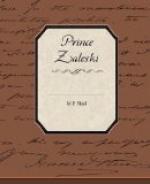’But let us bend our minds to the details of this matter. Let us ask first, who is this Ul-Jabal? I have said that he is a Persian, and of this there is abundant evidence in the narrative other than his mere name. Fragmentary as the document is, and not intended by the writer to afford the information, there is yet evidence of the religion of this man, of the particular sect of that religion to which he belonged, of his peculiar shade of colour, of the object of his stay at the manor-house of Saul, of the special tribe amongst whom he formerly lived. “What,” he asks, when his greedy eyes first light on the long-desired gem, “what is the meaning of the inscription ‘Has’”—the meaning which he so well knew. “One of the lost secrets of the world,” replies the baronet. But I can hardly understand a learned Orientalist speaking in that way about what appears to me a very patent circumstance: it is clear that he never earnestly applied himself to the solution of the riddle, or else—what is more likely, in spite of his rather high-flown estimate of his own “Reason”—that his mind, and the mind of his ancestors, never was able to go farther back in time than the Edmundsbury Monks. But they did not make the stone, nor did they dig it from the depths of the earth in Suffolk—they got it from some one, and it is not difficult to say with certainty from whom. The stone, then, might have been engraved by that someone, or by the someone from whom he received it, and so on back into the dimnesses of time. And consider the character of the engraving—it consists of a mythological animal, and some words, of which the letters “Has” only are distinguishable. But the animal, at least, is pure Persian. The Persians, you know, were not only quite worthy competitors with the Hebrews, the Egyptians, and later on the Greeks, for excellence in the glyptic art, but this fact is remarkable, that in much the same way that the figure of the scarabaeus on an intaglio or cameo is a pretty infallible indication of an Egyptian hand, so is that of a priest or a grotesque animal a sure indication of a Persian. We may say, then, from that evidence alone—though there is more—that this gem was certainly Persian. And having reached that point, the mystery of “Has” vanishes: for we at once jump at the conclusion that that too is Persian. But Persian, you say, written in English characters? Yes, and it was precisely this fact that made its




